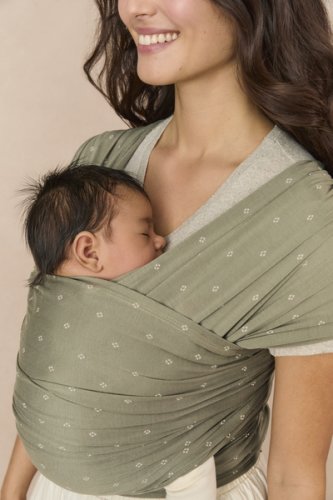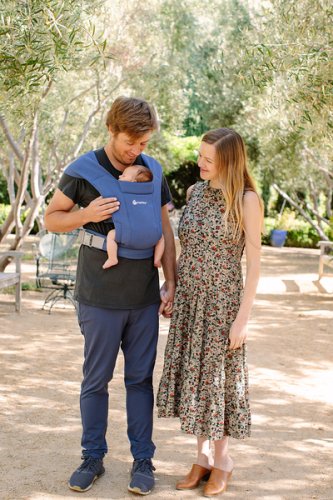
Welcoming a newborn into the world is an exciting journey filled with new experiences and responsibilities. There are so many things for a new parent to learn and we know it can be overwhelming.
One of the most common questions new parents ask is: “Are baby carriers safe for newborns?” This blog will explore the safety, benefits, and best practices for using a baby carrier with your newborn. We’ll cover essential aspects like the types of carriers, safety guidelines, benefits of babywearing, and tips for choosing the best infant carrier for newborns.
Understanding Baby Carriers
Baby carriers come in various styles, each designed to cater to different needs and preferences. The primary types of baby carriers include:
– Baby Wraps: Long pieces of fabric that wrap around the body to hold the baby close. Wraps are versatile and can be adjusted to fit newborns securely.
– Soft Structured Carriers (SSCs): These have padded straps and a structured seat, providing support for both the parent and the baby. Ergobaby’s range of SSCs is a popular choice for parents seeking comfort and safety. It’s important to note that not all SSCs are made equally. Many of Ergobaby’s carriers are newborn friendly as is. Other brands require newborn inserts for the safety of your baby.
When choosing a newborn carrier, it’s crucial to consider safety certifications and standards. Ergobaby carriers, for instance, are certified by the Juvenile Products Manufacturers Association (JPMA), ensuring they meet the highest safety standards.
Benefits of Using a Baby Carrier for Newborns
Baby carriers are so much more than helpful baby gear or a tool to use every once and awhile. They are an absolute essential for your mental health, postpartum recovery, bonding with baby, making travel easier, and so much more.
Using a baby carrier:
– Promotes Bonding and Attachment: Keeping your baby close helps strengthen the bond between you and your little one. The constant physical contact fosters a sense of security and trust.
– Supports Breastfeeding: Babywearing can make breastfeeding on the go more manageable, allowing for discreet nursing while keeping your hands free.
– Soothes and Calms the Baby: The gentle motion and warmth from being carried can help soothe a fussy baby, reducing crying and promoting relaxation.
– Hands-Free Mobility: A carrier allows parents to move freely, whether at home or out and about, making it easier to manage daily tasks.
Safety Considerations
Is a baby carrier safe for a newborn? Yes, but it’s essential to follow specific safety guidelines to ensure your baby’s well-being:
– Proper Positioning: Always ensure your newborn is in an ergonomic position, with their hips supported and their legs in an “M” shape. The baby’s back should be supported in its natural curve.
– Clear Airways: Keep your baby’s face visible and kissable, with their chin off their chest to prevent airway obstruction.
– Head and Neck Support: Newborns lack the strength to hold up their heads, so adequate support is crucial. Ergobaby carriers provide structured support to keep your baby’s head and neck stable.
– Regular Inspection: Frequently check your carrier for wear and tear, ensuring all straps and buckles are secure and in good condition.
Age and Weight Guidelines
Different carriers have varying age and weight limits. For example, many soft-structured carriers are suitable from birth up to 20.4kgs. It’s essential to follow the manufacturer’s guidelines to ensure your nwborn’s safety. Newborns typically weigh between 3 to 3.5kgs at birth, and many carriers can accommodate this range. Always check the specifications to see if the carrier supports newborns or if an infant insert is required.
Choosing the Best Baby Carrier for Newborns
When choosing the best baby carrier for newborns, consider the following features:
– Ergonomic Design: Supports proper hip development and provides comfort for both baby and parent.
– Adjustability: Allows for a customised fit as your baby grows.
– Breathable Material: Keeps the baby comfortable, especially in warmer climates.
If you’re looking for one carrier to support your babywearing journey from day 1 through the toddler years, the Omni carriers are your best option. Or you can opt for a newborn baby carrier that is designed specifically to support the 4th trimester like the Aura Wrap or Embrace.
Tips for Using a Baby Carrier with a Newborn
Here are some practical tips to ensure safe and comfortable babywearing:
- Follow Manufacturer’s Instructions: Always read and follow the carrier’s manual to ensure proper use.
- Practice at Home: Before venturing out, practice using the carrier at home to get comfortable with adjustments and positioning.
- Monitor Comfort: Pay attention to your baby’s cues. If they seem uncomfortable or fussy, check the carrier’s fit and position.
Common Myths and Misconceptions about Babywearing
– “Baby Carriers Are Unsafe for Newborns”: This is a common myth. When used correctly, baby carriers are safe and offer numerous benefits.
– “Babywearing Spoils the Baby”: Contrary to this belief, babywearing can help develop a secure attachment and promote independence as the baby grows.
– “Babywearing is just for hiking or traveling”: Babywearing is good everywhere, anytime.
Baby carriers are a safe and beneficial option for newborns when used correctly. They promote bonding, offer convenience, and provide a secure environment for your baby. As with any baby product, consult with your healthcare provider if you have any concerns.Check out our collection of carriers to find the perfect fit for your family’s needs.



















Can newborns go in a baby carrier?